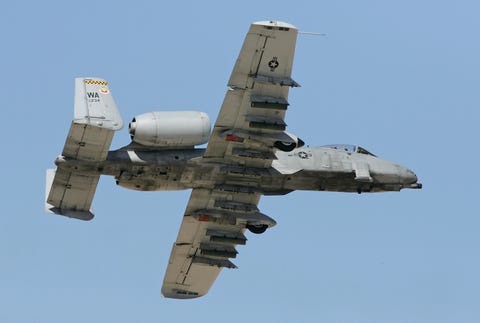A new contract will upgrade the entire Warthog fleet, alleviating concerns that the service was readying to retire a large number of A-10s.

Ethan MillerGetty Images
The Air Force awarded Boeing a contract to build 112 new sets of wings for the A-10.
Sixty percent of the A-10 fleet has new wings, but critics were concerned the last 100+ jets would be retired instead of rewinged.
The Air Force will eventually replace the A-10 with the F-35 in the close air support role.
The U.S. Air Force has awarded Boeing a contract to manufacture new wings for the A-10 Warthog. The jets, most of which date back to the 1980s, were in danger of being permanently grounded unless their aging wings were replaced. The new contract means the service’s entire fleet of 281 ground attack jets will get new wings, allowing them to fly through the 2030s.
The A-10 Thunderbolt, or “Warthog,” as it is affectionately known by everyone from pilots to ground troops, was the first U.S. Air Force aircraft purpose-built as a ground attack aircraft. The A-10 is designed to provide close air support to troops on the ground, knocking out tanks and strafing enemy troop columns threatening friendly forces.
The heavily armored plane is famous for its GAU-8/A seven-barrel 30-millimeter Gatling gun, whose famous BRRRRRRRRRRRRT! roar heralds its arrival over the battlefield.
In August, the USAF announced it had completed rewinging 173 A-10 of the 281 A-10s in service with the Air Force, Air Force Reserve, and Air National Guard. The effort, launched in 2011, had Boeing manufacturing new wing sets for A-10, sets that were then installed by A-10 maintainers at the Ogden Air Logistics Complex in Utah and Osan Air Base in South Korea.
The new wings are good for an additional 10,000 hours of flying, but only six of nine A-10 squadrons got them. That left open the possibility the Air Force could retire the remaining 108 jets or so. The Air Force has tried to replace the A-10 for decades, but each time the jet’s supporters in Congress and the other armed services rally to keep the planes flying.
Yesterday, the Air Force awarded Boeing a contract to build a maximum of 112 sets of new wings—enough to rewing the remaining A-10 inventory with a handful of spare wings left over. The Pentagon is buying 27 sets of wings right away at a cost of $239 million, or about $8.8 million per A-10. The remaining wings will be purchased in fiscal year 2020 or later.
The Air Force plans to eventually replace the A-10 with the F-35A Lightning II. The Air Force believes that, sooner or later, the aerial battlefield will become too dangerous for aircraft like the A-10 and a stealthier, faster jet is the way of the future. Critics contend the F-35A lacks a suitable gun and ammunition for strafing, cannot loiter over battlefields the way the A-10 can, and is not as survivable to enemy fire.
The F-35 also costs approximately $44,000 an hour to fly, while the A-10 costs just $19,000 to $20,000 an hour.